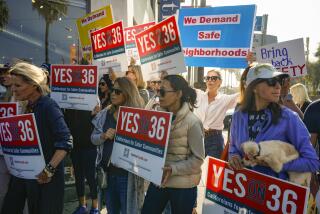State Panel Proposes Government Shakeup, One-House Legislature : Politics: Constitution Revision Commission also suggests merging some cities, counties and agencies to increase local powers. The plan, already the subject of debate, will go to the governor.
- Share via
SACRAMENTO — Searching for ways to shake up California’s creaky structure of government, a state commission proposed Friday that the state junk its traditional two-house Legislature in favor of a one-body unicameral state Senate with 121 members.
The unicameral proposal was just one of a host of dramatic changes in state and local government and the public school system, endorsed in concept by the 23-member Constitution Revision Commission.
Potentially, the most far-reaching proposal would allow voters to create new types of local super-governments formed through merging cities, counties, schools and special districts. That plan is designed to give the local governments strong new home rule powers and new taxing powers to pay for local services.
“I think we achieved substantially what I hoped to achieve,” said commission chairman William Hauck, a former Democratic legislative aide and more recently an adviser to Republican Gov. Pete Wilson.
The commission, composed of appointees of Wilson and state Assembly and Senate leaders, adopted changes Thursday and Friday that include a reformed state budget process, elimination of several state constitutional offices and the state boards of education and equalization, and revisions in public education finance.
But the process is by no means over, even though the commission has been at work for nearly two years. Hauck emphasized that the proposals worked out this week are strictly preliminary.
“We’ve left a whole range of questions open to continuing debate,” he said.
Sen. Lucy Killea (I-San Diego), the author of legislation that created the commission, also was the leading proponent of a unicameral Legislature. The single-house senators would be closer to their constituents, she said, because they would represent much smaller districts than do the present 40 senators and 80 Assembly members.
Now, she argued, members of the two houses represent the same people “and are doing exactly the same thing.”
State Sen. Bill Leonard (R-Big Bear) defended the two-house system, saying it provides the “careful scrutiny” that legislation must have. Nebraska is the only state with a unicameral legislature.
With refinements, the plan drafted this week covering five major areas of government will become a preliminary report to the governor and Legislature and be the subject of a series of public hearings throughout California this fall.
A final plan would go to the Legislature in January. The lawmakers would be asked to put it before California voters in the November, 1966, general election.
It takes a two-thirds approval of the Legislature to put an amendment on the ballot. Then, the approval of a majority of voters is needed for passage.
The most intense debate Friday concerned the state-local relationship, which has become muddled over the years by dramatic changes in governmental finance and a shift in power from local governments to Sacramento.
The idea behind the proposal to create so-called charter communities is to let local voters determine the form of government they want for the delivery of local services, from libraries to education to public utilities and health care. Voters also would have a greater say in how their tax money was spent.
There were several allusions to the financial situations of Los Angeles and Orange counties. One commissioner, USC Vice President Jane Pisano, cited a health care dilemma in Los Angeles County as an example of local government’s inability to respond to local crises.
“The status quo just isn’t viable,” said Pisano, who was a member of the county’s health crisis task force.
Pisano said she had reservations about the charter community concept, but added, “I just feel we’ve got to send a message, even if it is with a blunt weapon.”
The plan would allow any combination of existing local governments to join in a community charter venture to attack local problems and fulfill needs in a manner determined by local voters. No agency would be compelled to join, but there would be strong financial incentives to do so.
A charter community could consist of an entire county and one or more other governments or agencies within it, or part of a county. Or, one county might want to join with a neighboring county to jointly operate some functions, as is now done in some cases under existing joint-powers agreements.
The charter community would be able to control the spending of local property tax revenues, city and county shares of the sales tax and motor vehicle fees.
School districts would be encouraged to join because schools within a charter community would be allowed to raise additional sales and property taxes, if approved by the voters. School districts that remained out of the new organization would not have the new taxing power.
The idea was opposed by state Legislative Analyst Elizabeth Hill, a longtime proponent of realigning state and local services. She said she believes that a state-local partnership should be maintained and that the commission’s plan would tend to cut that link.
But several other commission members said the partnership has been spoiled by the tendency of the state to dump more and more duties on cities and counties without the money to finance them.
“The level of distrust is just frightening to me,” said Superior Court Judge Roger Warren of Sacramento, a commission member. “I am amazed at the extent of frustration at the local level.”
Commission member Andrew Baron, a representative of public employee unions, also cited “an incredible lack of faith by the people in their governments.” Without strong action, Baron said, “the L.A. County health crisis is a precursor of what is going to be happening around the state.”
The commission also voted to eliminate the office of state superintendent of public instruction, the State Board of Education and county boards of education.
The elected offices of state insurance commissioner and state treasurer would be made appointive, by the governor. The functions of the State Board of Equalization and the Franchise Tax Board would be combined into one administrative Department of Finance, a proposal that has been made many times over the past 35 years.
More to Read
Get the L.A. Times Politics newsletter
Deeply reported insights into legislation, politics and policy from Sacramento, Washington and beyond. In your inbox twice per week.
You may occasionally receive promotional content from the Los Angeles Times.










